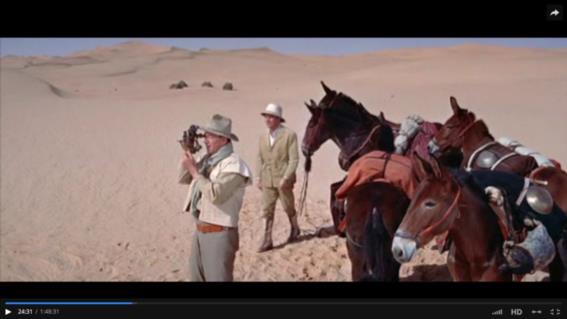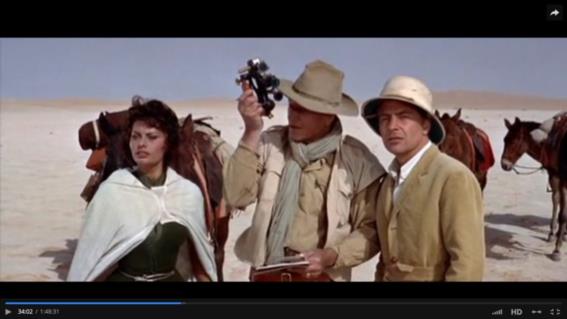
NavList:
A Community Devoted to the Preservation and Practice of Celestial Navigation and Other Methods of Traditional Wayfinding
From: Frank Reed
Date: 2016 Dec 3, 13:03 -0800
Ed Popko, you wrote:
"Perhaps it is this one - Legend of the Lost, a 1957 Italian-American Adventure film starring John Wayne and Sophia Loren"
That's where the image is from, yes. Gary LaPook has posted about this scene a number of times. You can watch "Legend of the Lost" here, and this sextant scene is at time stamp 24:30. The image you posted and quoted says "John is trying to fix the location of a distant camel train." But that appears to be a misinterpretation of the scene. They dismount in this scene because they're worried that they're being followed by a group of riders on camels, and as Wayne's character, named "Joe January", says "There's only one way to find out". They stop, and Joe fiddles with his sextant in this scene. I interpret this is as a "just act natural" maneuver. He's playing with the sextant so that they appear to be doing something "harmless" so as not to attract attention while the group of possibly dangerous men on camels passes by --which they do, demonstrating that they are not being followed. He says nothing about any sextant readings.
There is also a scene near time stamp 34:00 where Joe (Wayne) makes some interesting, and perhaps physically reasonable comments about a mirage. In this scene, too, he fiddles with his sextant and appears to read the micrometer, but this could be after he has performed an observation which we do not get to see on-screen. We don't know. As Gary has noted before, there's no evidence of an artificial horizon or a bubble attachment, and the marine sextant shown in the film would be useless for navigation in the desert without such. Really though, that's a nitpick.
At time stamp 52:30, there's a discussion of navigation which is entertaining. Joe January (John Wayne) is snarling at Paul Bonnard (Rossano Brazzi), interrogating him about the location of this supposed lost city in the desert discovered by Bonnard's father. Borrowing from the subtitles for the movie:
JJ: "Take a look at this chart. It tells the story.
PB: "We are in or near the tropic of Cancer."
JJ: "We are at EXACTLY 23 and a half degrees north of the equator! We are ON the tropic of Cancer. I know where we are! Where do you think we're going?"
PB: "My father went from 23 and a half degrees north, by 5 west, using dead reckoning to approximately 5 degrees and 30 minutes west."
JJ: "Approximately! Dead reckoning! A half a degree error can mean 30 or 40 miles!"
That all rings right. The location is in northern Mali in the Sahara, and it's consistent with the rest of the film. The complaint about "dead reckoning" would be reasonable for a post-war navigator skilled with a sextant who would have been taught that "dead reckoning" is deadly. Calling half a degree "30 or 40 miles" is a bit funny. If he had said "30 nautical miles or 35 statute miles" that would have been accurate --but not very "John Wayne", right?
I didn't watch the whole movie. There may be other navigation-related moments that I missed.
Frank Reed
PS: Four steps from "Legend of the Lost" to Star Trek:
1) Rossano Brazzi is in Legend.
2) A year later, Brazzi was also in "South Pacific" as Emile.
3) Also in "South Pacific", in her first movie role, France Nuyen played "Liat".
4) Nine years later, Nuyen played the shrewish Elaan in Star Trek's "Elaan of Troyius".
In my next trick I'll get you from here to an anachronistic octant in a production of "Hamlet" (of a sort).








